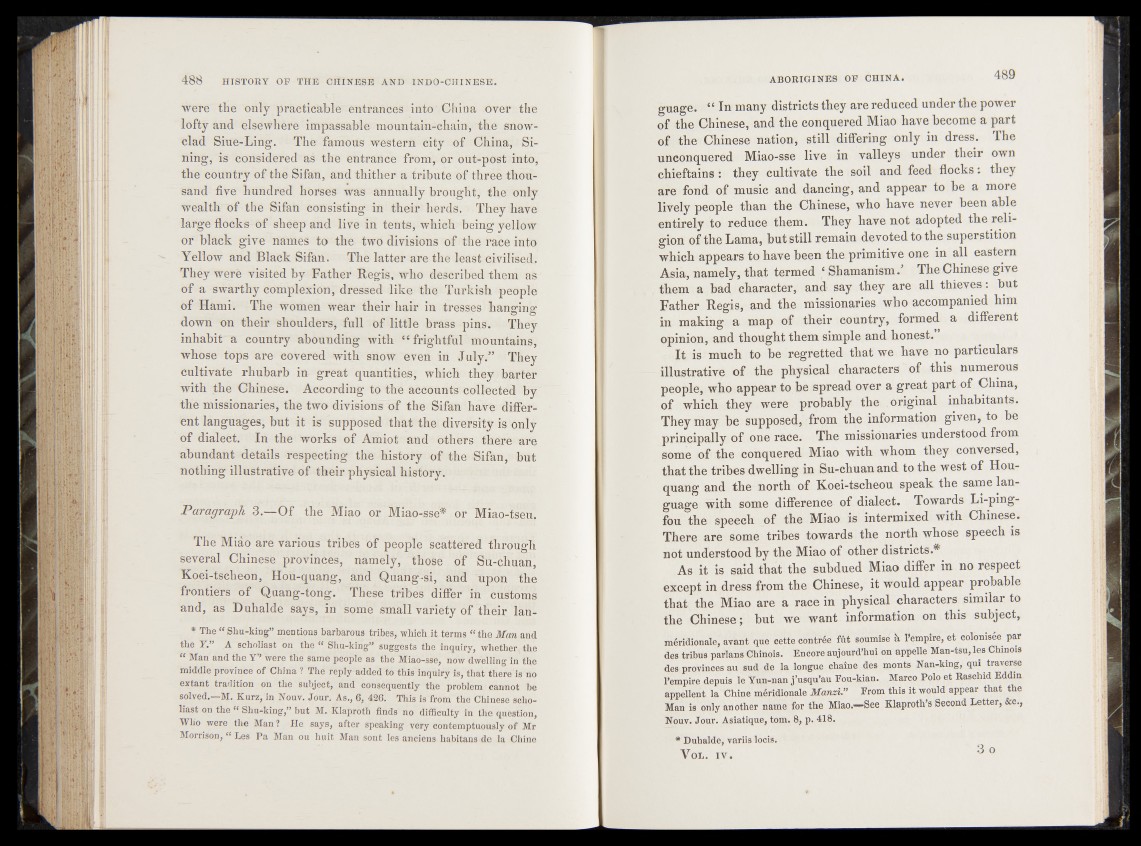
were~tM oMj pPàcticEblë-cntranCHS in'to'Chîna over the
lofty and elséwhère impassable mountain-chain, the snow-
clad Sine-Ling. The famous western city of China, § Si-
ning, M %(Hï§îÉëFëd"aê the entrane% "from, or otit-post into,
the country of the Sifan, and thither a tribute of three thousand
five hundred horses was annually brought, the only
wealth of the Sifan consisting in their herds. • They have
large flocks öf shëép and live in tents, which being yellow
or black give names to the two divisions of the race intO:
Yellow and Black Sifan. The latter are the least civilised?
Théy were visited by Father Regis, who described them- as
of a swarthy complexion^ dressed dike the< Turkish people
of Kami. The women wear their hair in tresses hansrinar
down on their shoulders, full : of little brass pips. They
inhabit'a country abounding with “ frightful 'mDuntains,
whose tops are covered with snow even in J uly/’ They
cultivate rhubarb in great quantities, which ' they/ barter
with the Chinese. According to the accounts collected by
the missionaries, thé two
ent lângpagés, but it is supposed that the diversity is^nly
of dialect. In the works of Anbiot’ and Mh^s
abundant details respecting the history of theî#ifàn,'Hb®t
nothing illustrative of their physical hislèryî'51
Paragraph 3.—Of the Miabor/feo-sse* or MialpIjS
The Miao are various tribes of people scattered through
several Chinese provinces, namely, those of Su-cBUan)
Koèi-tscheon, HoU-quang, and Quang-fil, and Upon the
frontiers of Quang-iorig. These tribes differ in ' étiftbms
and, as Duhaldé says, in some small vaïiétÿ óf their làiil
* 1he “ Shu-king” men tionsbarbarous tribes, whieh.it terms “ the Man and
the T ” jA scholiast on the SÈu-king’’ suggests the inquiry, whether^ the
“ Man and the Ÿ* wére the' same people as the Miao-sse, now dwelling'in the
middle provitfeè of China ? The rëply-added tó thifinquiry Is, that there'is no
extant tradition on the subject, and consequently the problem cannot be
splyed.—M. Kurz,'in Nouv. Jour. As., 0, 426. This is‘from the Chinese scholiast
oh the “ Shu-king,” Mt M. Klaprôth finds no difficulty in the question,
Who were the Man ? ^He says, after speaking very contemptuously of Mr
Morrison, “ Les Pa Man ou huit Man sont les anciens habitans de la Chiné
guage. 1 In many districts they are reduced under the power
of the Chinese, and the conquered Miao have become a part
of the Chinese nation, still differing only in dress. The
unconquered Miao-sse live in valleys under their own
chieftains : they cultivate the soil and feed flocks: they
are fond of music and dancing, and appear to be a more
lively people than the Chinese, who have never been able
entirely to reduce them. They have not adopted the religion
of the Lama, but still remain devoted to the superstition
which appears to have been the primitive one in all eastern
Asia, namely, that termed ‘ Shamanism/ The Chinese give
them a bad character, and- say they are all thieves : but
Father Regis, and the missionaries who accompanied him
in making a map of their country, formed a different
opinion, and thought them simple and honest/’
It is much to he regretted that we have no particulars
illustrative of the physical characters of this numerous
people, who appear to be spread over a great part of China,
of which they were probably the ,original inhabitants.
They may he supposed, from the information given, to he
principally of one race. The missionaries understood from
some of the conquered Miao with whom they conversed,
that the tribes dwelling in Suleiman and to the west of Hou-
quang and the north of Koei-tscheou speak the same language
with some difference of dialect. Towards Li-ping-
fou the speech of the Miao is intermixed with Chinese.
There are some tribes towards the north whose speech is
not understood by the Miao of other districts.*
As it is said that the subdued Miao differ in no respeet
except in dress from the Chinese, it would appear probable
that the Miao are a race in physical characters similar to
the Chinese ; hut we want information on this subject,
méridionale, avànt que cette contrée fût soumise & Témpire, et colonisée par
des tribus parlant Chinois. Encore aujourd’hui on appelle Man-tsu, les Chinois
des provinces au sud de la longue çha,îne des monts Nan-king, qui traverse
l’empirp depuis le Yun-nap j ’usqni’au Fou-Jrian., Marco Pole et Raschid Eddin.
appellent la 'Chine méridionale Manzi” From this it would appear that the
Man is only another name for the Miao.—See Klaproth’s Second Letter, See.,
Nouv. Jour. Asiatique, tom. 8, p. 418.
* Duhalde, variis locis.
VOL. IV. - 3 °